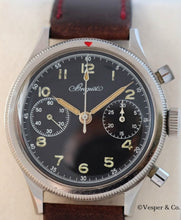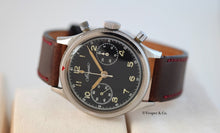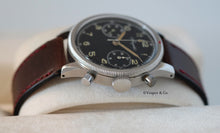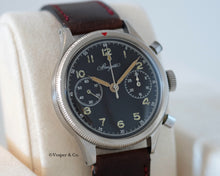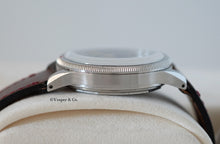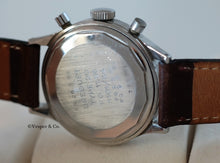
Breguet. A Rare and Early Stainless Steel Chronograph Wristwatch Issued by the French Military
Model: Type 20
Circa: 1954
Valjoux Cal. 222 mechanical movement, 17 jewels, black matte dial, luminous Arabic numerals, outer minute divisions with Arabic numerals, luminous hands, two subsidiary dials for 30 minute register and constant seconds, circular stainless steel case, stainless steel bezel with red arrow and reeded edge, two round chronograph buttons in the band, downturned lugs, screw back engraved with FG dates, case, dial, and movement signed
40mm.
More about Breguet:
While many may associate the name Breguet with horological advancements and the tourbillon complication, the brand also has a long history with the field of aviation. Louis-Charles Breguet, the great-great-grandson of Abraham Louis Breguet, founder of the brand, was a French aviator, plane manufacturer and engineer. In 1909, he built his first airplane, and during the first World War, he designed the Breguet XIV aircraft, which was mass produced for the French airforce. In 1919, he created a commercial air transport company called Compagnie Des Messageries Avienne, which later became Air France. One of his most successful planes, the Breguet XIX, was one of the first to be used for long distance flights, and in 1927 made the first successful crossing of the South Atlantic.
The French Ministry of Defense required a pilot’s wristwatch to be standard equipment, often using pieces manufactured in Germany, Britain, or America, finally deciding after World War II they wanted to start fresh with new accurate timepieces. Thus, the Type 20 was developed to provide pilots with a chronograph that was not only accurate, but readable and with an immediacy of change. The time between stopping, resetting, and re-starting a chronograph could mean the difference between life and death for pilots, who needed to be able to immediately start their chronograph after finishing timing an event. The Type 20 model was one of the first to have a fly-back movement, in which the chronograph is instantly reset just by pushing the lower chronograph button. A form of flyback function was earlier invented in 1936 by Longines-Francillon, but theirs used a single pusher and was unable to stop the chronograph to read the time.
It is important to note that the Type 20 model was not just produced by Breguet – this designation was given by the French Ministry of Defense and applied to chronographs that were produced to military specifications. Such watches were produced by Breguet, J. Auricoste, Vixa, and Dodane. These watches were inspired by the models produced during World War II by Tutima and Hanhart, with black dials, luminous Arabic numerals and hands, and two subdials at 3 and 9 o’clock. These watches were also sized at 38mm to be easily readable by pilots, and had a rotating bezel. The movements were produced by Valjoux, Lemania, or Hanhardt, and used a screw-down case back.
In 1954, Breguet was commissioned to produce 2000 Type 20 watches, and the casebacks were engraved “Breguet, Type 20, 5101/54” for the contract number and year. As Breguet was still based in France and needed to produce a large number of watches in a short amount of time, production of the watches was contracted out – Breguet used the Valjoux 222 movement, and the watches were assembled by Mathey-Tissot. Having put together these watches, a number watches are known to exist with movements, cases, and dials signed Mathey Tissot, and were sold to civilians. Later, Breguet would produce their own civilian version, with their name on the dial and slight variations, including three registers on the dial.
The Breguet-produced watches for the French military were given to the Armée de l’air (French Air Force), Marine Nationale (French Naval Army) and Centre d’essais en vol (French Flight Tests Center), also known as CEV. These watches needed to be inspected for accuracy and after each inspection, the date of the next scheduled examination would be engraved on the back with the letters “FG” – Fin de Garantie, end of warranty. The Type 20 watches were used by the French military through the 1980’s, and were often replaced by quartz models. The present watch was used for over twenty years, as indicated by the FG marks “11/56, 2/x/xx, 28/x/xx, 9/x/xx, 21/7/76”.
In the 1990’s, Breguet re-introduced the Type XX model with a modern automatic flyback chronograph, changing the model name from Type 20 (written with Arabic numerals) to Type XX (Roman numerals). While the modern examples went on to enjoy much success, the vintage military-issued models are desired by collectors for their importance to Breguet. The orders from the military certainly made a difference in the company being able to produce watches during a time when many companies struggled financially and had difficulty sourcing materials to produce watches. These watches also have a classic design, despite being produced purely for “tool” purposes, and each one tells a different story through its engravings. The present watch is an exemplary specimen, with crisp engravings and a beautifully aged dial, in spite of the many years of servicing, indicating that the French military took great care to ensure the longevity of the timepieces they issued.






